Public attitudes to coronavirus: October update
High level findings from recent polling work on public attitudes to the coronavirus pandemic in Scotland.
This document is part of a collection
2. Attitudes to Coronavirus guidance and restrictions
Views on guidance
As well as tracking the impacts of the Coronavirus on wellbeing and daily life, surveys have also been used to monitor people's attitudes to the Coronavirus response. This section presents polling data relevant to trust in government advice and willingness to comply with Coronavirus measures.
Figure 11 shows that at the end of March the vast majority (89%) agreed or strongly agreed that the best thing to do is follow the government's advice, and this has decreased steadily to 77% in August. It also shows that a minority agreed that they find it easy to join in if their friends and family are not quite sticking to the rules, and this increased in early and late June and has stayed stable since.
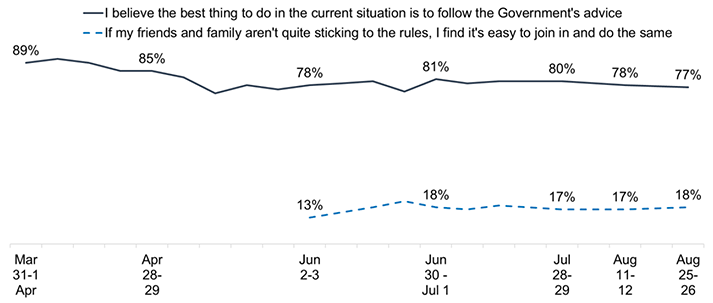
Source: YouGov weekly Scotland survey. Base (n=1001-1048)
Chart Description
This figure shows a line graph with two lines. One line shows the proportion of respondents who strongly agreed or agreed with the statement ‘I believe the best thing to do in the current situation is to follow the government’s advice’ from 31 March-1 April to 25-26 August; this has decreased since 31 March-1 April, with 77% reporting this at the most recent time point. The second line shows the proportion of respondents who strongly agreed or agreed with the statement ‘If my friends and family aren’t quite sticking to the rules, I find it’s easy to join in and do the same’ from 2-3 June to 25-26 August; this has increased slightly since 2-3 June, with 18% reporting this at the most recent time point.
Personal protective actions
Respondents were asked when, if ever, they currently wear a face covering when they leave the house. Figure 12 shows that the proportion of respondents reporting to wear a face covering at least sometimes has increased since the beginning of May to 93%. This increase was fairly steady at the beginning, but rose sharply in July when the wearing of face coverings became mandatory in certain settings.
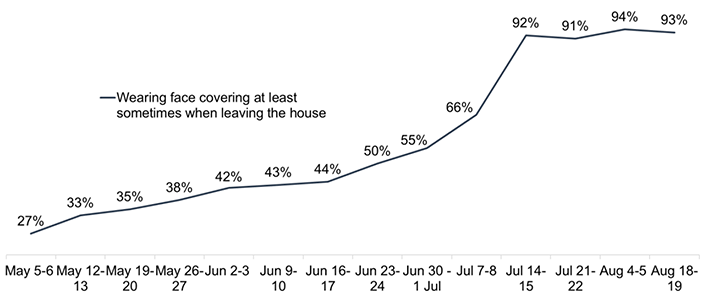
Source: YouGov weekly Scotland survey. Base (n=1001-1048)
Chart Description
This figure shows a line graph with one line. The line shows the proportion of respondents who reported wearing a face covering at least sometimes when leaving the house from 5-6 May to 18-19 August. This has increased to 93% at the most recent time point.
Respondents were asked the extent to which they agreed or disagreed with the statements shown in Figure 13 regarding restrictions and guidelines. Figure 13 shows that the majority of respondents agreed that they feel clear about what is required of people as restrictions change, and agreement has remained between 75% and 82% since mid-June. Figure 13 also shows that the proportion of respondents who find it hard to always stick to government guidelines has increased since early-April, although it has remained stable since the middle of June.
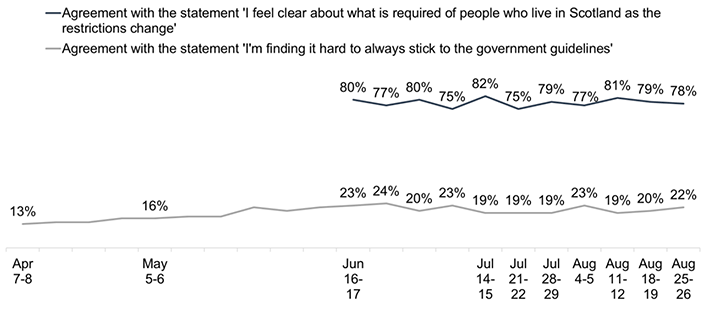
Source: YouGov weekly Scotland survey. Base (n=1001-1048)
Chart Description
This figure shows a line graph with two lines. One line shows the proportion of respondents who strongly agreed or agreed with the statement ‘I’m finding it hard to always stick to the government guidelines’ from 7-8 April to 25-26 August; this has been stable since mid-June, with 22% reporting this at the most recent time point. The second line shows the proportion of respondents who strongly agreed or agreed with the statement ‘I feel clear about what is required of people who live in Scotland as the restrictions change’ from 16-17 June to 15-26 August; this has remained relatively stable since 16-17 June, with 78% reporting this at the most recent time point.
Testing
Respondents were asked whether they had heard of Test & Protect, and how much they felt they know about the Test & Protect programme. Only one of these questions was asked in the latest survey wave (25-26 August). Figure 14 shows that levels of awareness have increased slightly since the beginning of June. When asked how much they know about Test & Protect, between three fifths and two thirds answered that they feel they know 'a great deal' or 'a fair amount'.
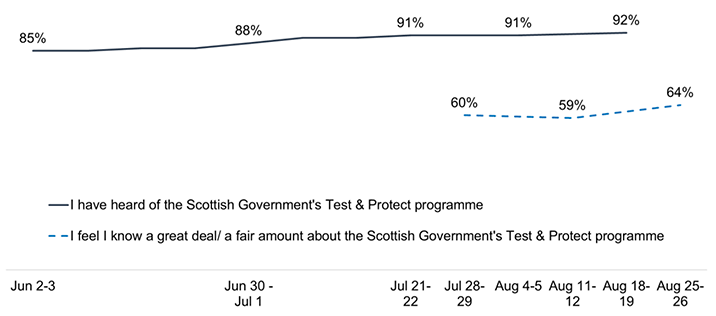
Source: YouGov weekly Scotland survey. Base (n=1001-1048)
Chart Description
This figure shows a line graph with two lines. One line shows the proportion of respondents who said yes ‘I have heard of the Scottish Government’s Test & Protect programme’ from 2-3 June to 18-19 August; this has increased slightly from 2-3 June with 92% reporting this at the most recent time point. The second line shows the proportion of respondents who said they know a great deal or a fair amount about the Scottish Government’s Test & Protect programme from 28-29 July to 25-26 August; this has remained fairly stable, with 64% reporting this at the most recent time point.
Figure 15 shows that the majority of respondents agreed that they would be happy to provide details of their contacts and be willing to isolate for 14 days if told to do so; both of these measures have increased slightly since the beginning of June.
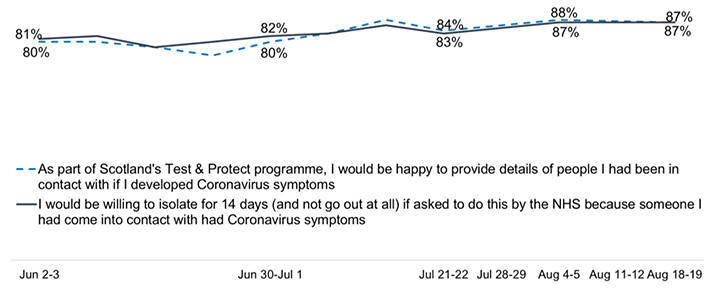
Source: YouGov weekly Scotland survey. Base (n=1001-1048)
Chart Description
This figure shows a line graph with two lines. One line shows the proportion of respondents who strongly agreed or agreed with the statement ‘As part of Scotland’s Test & Protect programme, I would be happy to provide details of people I had been in contact with if I developed Coronavirus symptoms’ from 2-3 June to 25-26 August; this has increased since 2-3 June, with 87% reporting this at the most recent time point. The second line shows the proportion of respondents who strongly agreed or agreed with the statement ‘I would be willing to isolate for 14 days (and not go out at all) if asked to do this by the NHS because someone I had come into contact with had coronavirus symptoms’ from 2-3 June to 25-26 August; this has increased since 2-3 June, with 87% reporting this at the most recent time point.
Rating of government
Respondents were asked how good or poor a job various institutions are doing to help Scotland deal with the recovery following the pandemic. Previously, respondents of the Ipsos MORI survey were asked how good or poor each of the following was doing to contain the spread of the virus. [8] As shown in Figure 16, respondents have consistently rated the NHS highly. The proportion who rated the Scottish Government as doing a 'good/very good' job has also remained high and fairly stable. Ratings of the UK Government to help Scotland deal with recovery following the pandemic have been lower than ratings of Scottish Government but have remained consistent.
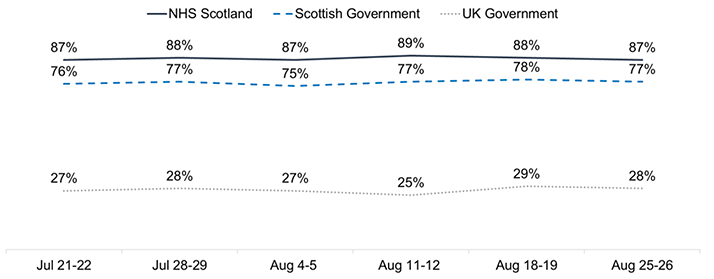
Source: YouGov weekly Scotland survey. Base (n=912-1048)
Chart Description
This figure shows a line graph with three lines. One line shows the proportion of respondents who thought that NHS Scotland were doing a very good or good job to help Scotland deal with recovery following the pandemic from 21-22 July to 25-26 August; this has been stable, with 87% reporting this at the latest time point. The second line shows the proportion of respondents who thought that the Scottish Government were doing a very good or good job to help Scotland deal with recovery following the pandemic from 21-22 July to 25-26 August; this has been stable, with 77% reporting this at the latest time point. The third line shows the proportion of respondents who thought that the UK Government were doing a very good or good job to help Scotland deal with recovery following the pandemic from 21-22 July to 25-26 August; this has been stable, with 28% reporting this at the latest time point.
Trust in Scottish Government
Respondents were asked on a fortnightly basis to what extent they trust the Scottish Government to work in Scotland's best interests during the Coronavirus pandemic. As shown in Figure 17, around three quarters of respondents trust the Scottish Government either 'a great deal' or 'quite a lot', and since mid-July the proportion who report 'a great deal' of trust decreased slightly.
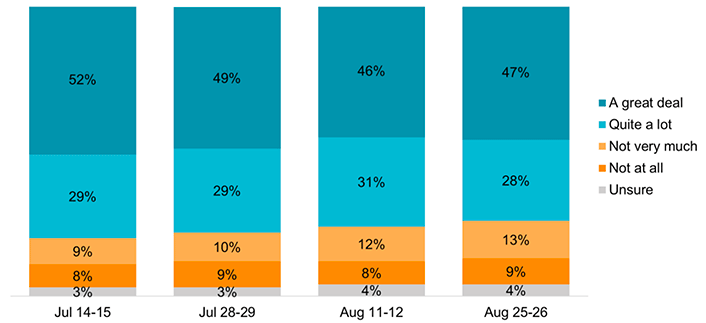
Source: YouGov weekly Scotland survey. Base (n=1001-1012)
Chart Description
This figure shows a bar chart with four bars. Each bar shows the proportion of respondents who reported that they trust the Scottish Government to work in Scotland’s best interests during the coronavirus pandemic ‘a great deal’, ‘quite a lot’, ‘not very much’, ‘not at all’, or ‘unsure’. Data is shown from 14-15 July to 25-26 August. The proportion of respondents who trust the Scottish Government ‘a great deal’ has decreased slightly since 14-15 July, with 47% reporting this at the most recent time point.
Trust in Scottish Government advice and guidance
Respondents were asked whether they agreed or disagreed with statements about trust in advice from Scottish Government, and trust in the Scottish Government to decide when to lift (or re-impose) restrictions. Figure 18 shows that the majority agreed that they trust advice and guidance from the Scottish Government about Coronavirus, and to decide when and how to lift restrictions. Trust in Scottish Government to deal with local outbreaks is also high and has remained consistent since mid-July, with around three quarters agreeing that they trust Scottish Government to monitor and respond to localised outbreaks.
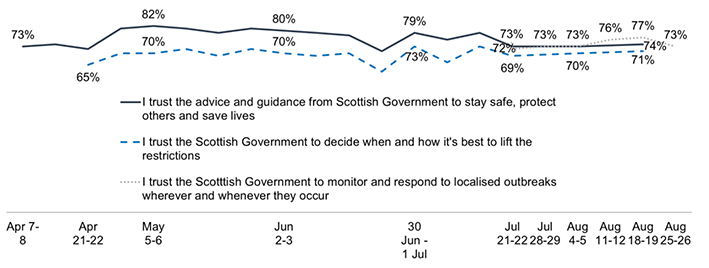
Source: YouGov weekly Scotland survey. Base (n=1001-1048)
Chart Description
This figure shows a line graph with three lines. One line shows the proportion of respondents who strongly agreed or agreed with the statement ‘I trust the advice and guidance from Scottish Government to stay safe, protect others and save lives’ from 7-8 April to 18-19 August; this has fluctuated a little since 7-8 April, with 74% reporting this at the most recent time point. The second line shows the proportion of respondents who strongly agreed or agreed with the statement ‘I trust the Scottish Government to decide when and how it’s best to lift the restrictions’ from 21-22 April to 18-19 August; this has increased slightly since 21-22 April, with 71% reporting this at the most recent time point. The third line shows the proportion of respondents who strongly agreed or agreed with the statement ‘I trust the Scottish Government to monitor and respond to localised outbreaks wherever and whenever they occur’ from 21-22 July to 25-26 August; this has been stable with 73% reporting this at the most recent time point.
Sources of information
Respondents were shown a list of information sources and asked about the degree to which they trust the source to deliver information on Coronavirus.[10] As shown in Figure 19, there have been continued high levels of trust in scientists to deliver information about Coronavirus, with a small increase in the most recent wave. The proportion who trust the Scottish Government has been consistently higher than the proportion who trust the UK Government to deliver information about Coronavirus.
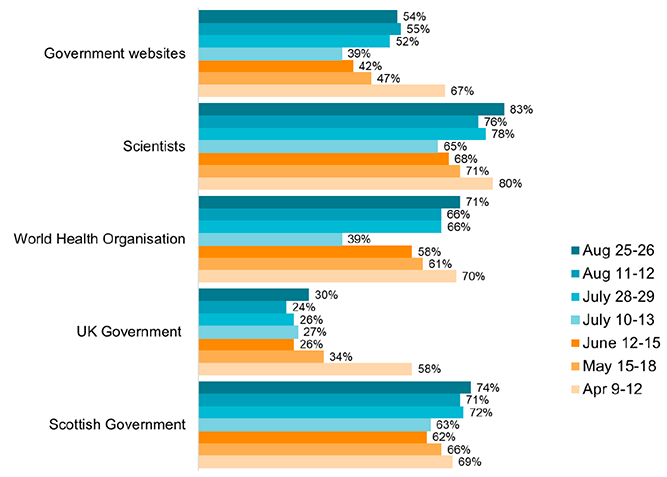
Sources: Ipsos MORI to July 10-13; Base (n=500-665), YouGov weekly Scotland survey since. Base (n=1004-1008)
Chart Description
This figure shows a bar chart that shows the proportion of respondents who completely or mostly trust various information sources to provide information on coronavirus across seven time points: 9-12 April, 15-18 May, 12-15 June, 10-13 July, 28-29 July, 11-12 August and 25-26 August. The proportion of respondents who trust the Scottish Government has increased slightly since 9-12 April, with 74% reporting this at 25-26 August.
Respondents were shown a list of information sources and asked which they use regularly to access information on coronavirus (i.e. at least three times a week). As shown in Figure 20, the most commonly used sources are the First Minister's daily briefing and BBC TV News. There has been an increase in the proportion accessing Scottish Government websites and social media for information on Coronavirus since May.
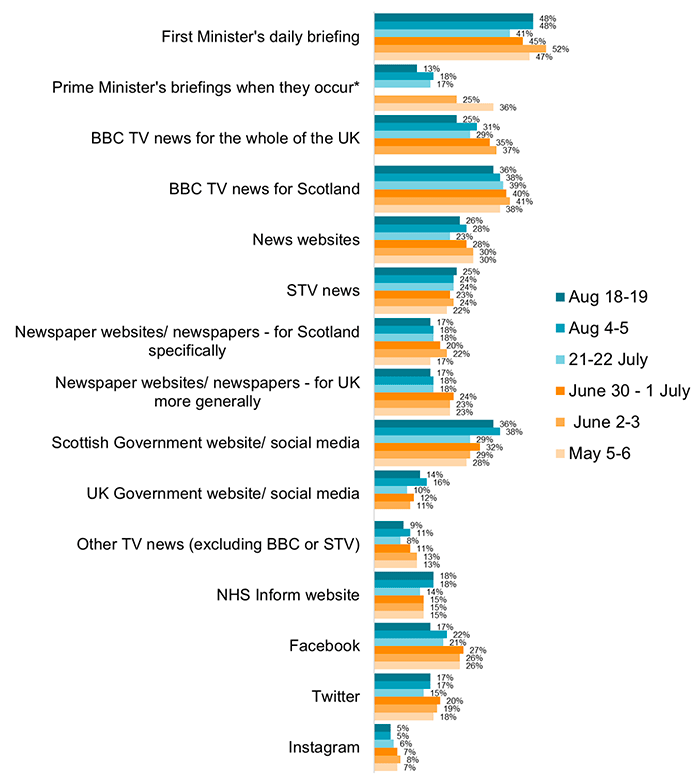
Source: YouGov weekly Scotland survey. Base (n=1001-1048)
Chart Description
This figure shows a bar chart that shows the proportion of respondents who use various information sources regularly to access information on coronavirus across six time points: 5-6 May, 2-3 July, 30 June – 1 July, 21-22 July, 4-5 August and 18-19 August. The First Minister’s daily briefing is the most commonly reported source, with 48% using it at the most recent time point.
Contact
Email: covid-19.behaviours@gov.scot
There is a problem
Thanks for your feedback